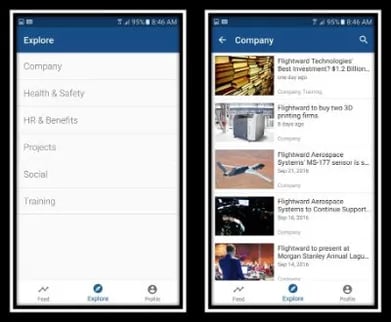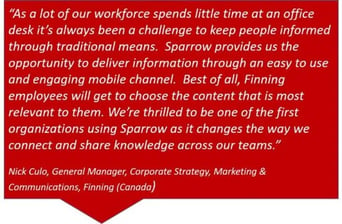This post was originally written by Priya Bates, ABC, MC, CMP, and IABC Fellow from Inner Strength Communication Inc. Visit her website at www.innerstrengthcommunication.com
How do you connect with employees who are in the field or on the floor? You know…the ones who don’t sit at a desk with a computer. ”This has to be one of the most frequent questions I get asked when talking to corporate and internal communication practitioners. Whether it’s a retail organization with the majority of employees on the shop or distribution floor; a healthcare organization where staff are mobile and focused on patient care; a sales or shipping environment where staff are on the road; we struggle with connecting and communicating with the non-office employee base.
It’s the reason I’ve recently started asking a lot of questions about BYOD (Bring Your Own Device) policies and employee apps and why I was pleased to connect with Chris Izquierdo, CEO of Canadian-based DevFacto Technologies Inc. to review Sparrow, their new Employee App solution.
Tool Talk
Sparrow is a mobile app that securely sends targeted corporate communications to employee mobile devices. According to Chris, clients started asking for solutions for mobile workers and after a review of what existed in the marketplace, DevFacto decided to build its own version. The first generation of the tool allows employees to sign up to receive information that is personalized and relevant to them. It accomplishes this by setting up an employee profile for mandatory messages and allows the recipient to also opt-in to areas of interest.

Behind the scenes, the tool also offers rich analytics to track reach and awareness to measure success. The detailed dashboard helps you understand open rates; whether the message was read, skimmed, or scrolled; and provides a breakdown of analytics by employee role. On a larger scale, the dashboard helps you understand awareness levels of particular topics (i.e. “safety gloves”) based on accumulated data over time. Finally, the tool allows recipients to react to content and share content internally or externally (if applicable and permissible) via their personal social media tools.
Future versions of Sparrow will allow for integration with organizational chart structures to target messages more proactively, ability to share video, and eventually add access to business tools and reports to make the App a business and communication tool.
Nuts and Bolts
What excited me about the implementation of Sparrow was that it was designed to work with existing enterprise tools and content management systems to make it easier on the business and communication professional.
There is some work up front with your IT teams to create linkages and permissions to drive authentication of corporate credentials and manage security. There also needs to be work on governance to create content submission and approval processes as well as training for employees and content providers, but this should be the case with any technology launch or upgrade.
What was clear from our conversation was that the tool doesn’t exist in a vacuum. Just because an organization purchased the tool didn’t automatically guarantee success. An organization needs to ensure there is an internal communication infrastructure that consists of both communication professionals and relevant business professionals providing content regularly in order for the tool to succeed. For small communication departments, there is an opportunity to identify business communication partners, train them on guidelines, and encourage them to support the communication effort.
Does it Measure Up?
Measurement is always a key factor in assessing success of communication tools. One of Sparrow’s early adopters, Finning (Canada), whose staff consists of mechanics in field, has seen a 400% increase in readers of content on the App versus readership on the intranet. Even more amazing, 38% of readers access content outside of business hours. I was personally surprised by the high percentage of mobile employees downloading the app – over 70%.

I asked Chris if the enquiries for the tool came from internal communication staff. His answer concerned me. He was often approached by business leaders and HR leaders who wanted to fix the business problem of engaging mobile, non-desk workers. Once brought in, he commented that communicators were more-often-than-not seen as hesitant to adopt new tools.
I imagined that this was the result of under-resourced communication staff not being part of the decision-making process, but it’s too early to understand the reasons for this experience.
In the next few years, as flexible workspaces and mobile workforces grow, I think we’ll see more success stories on Employee Apps like Sparrow. Let’s ensure communication professionals are leading the solution conversation or clearly identifying what’s needed for successful launch, adoption and maintenance.





